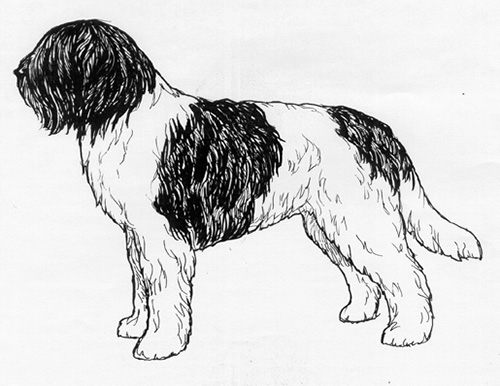Schapendoes
Herding Dog Group
The goals and purposes of this breed standard include: to furnish guidelines for breeders who wish to maintain the quality of their breed and to improve it; to advance this breed to a state of similarity throughout the world; and to act as a guide for judges.
Breeders and judges have the responsibility to avoid any conditions or exaggerations that are detrimental to the health, welfare, essence and soundness of this breed, and must take the responsibility to see that these are not perpetuated.
Any departure from the following should be considered a fault, and the seriousness with which the fault should be regarded should be in exact proportion to its degree and its effect upon the health and welfare of the dog and on the dog’s ability to perform its traditional work.
History
The Schapendoes (also known as the Dutch Sheepdog) is a member of a wide-ranging group of long-haired herding dogs that have densely coated heads. At the turn of the century the breed was well known in the Netherlands, being prized for his intelligence and the tireless pleasure that he took in his work. Following the World War ll, the breed was resurrected from a few remaining individuals. The first breed club was founded in 1947, a standard written in 1954, and complete recognition came in 1971.
The Schapendoes was recognized by the United Kennel Club in 2006.
General Appearance
The Schapendoes is a medium sized, lightly built, long coated dog that is equipped with great endurance, mobility and speed. His movement is springy and he is a remarkable jumper.
Characteristics
This is a true herding dog in character, body and soul. He is attentive, courageous, intelligent and watchful. He is extremely loyal and affectionate towards his family.
Head
The abundant hair on the head gives it the impression of being bigger, and particularly broader, than it actually is.
SKULL
The skull is almost flat, with a moderate frontal furrow and well defined superciliary arches. It is broader than it is long. The stop is clearly defined but not steep.
MUZZLE
The muzzle is shorter than the skull, deep and broad to the end, which is only slightly rounded. The underjaw is well-developed and the cheeks are prominent.
TEETH
The Schapendoes has a complete set of evenly spaced, white teeth meeting in a scissors bite.
NOSE
The bridge of the nose is placed a little lower than the line of the skull.
EYES
The eyes are fairly large, round and set forward on the skull. They are brown in color, and should not give the impression of being black. The expression is honest, open and lively.
EARS
The ears are set on fairly high, and hang freely, but not close to the head. They are not large or fleshy. They are well covered with hair, and mobile, but should not protrude beyond the outline of the skull.
NECK
The strong, clean neck carries the head well up.
Forequarters
The shoulders are well-angulated.
FORELEGS
Straight and lightly boned, with springy pasterns.
Body
In proportion, the Schapendoes is slightly longer than tall. The skeleton is fine-boned and elastic. The chest is deep, with good forechest, and the ribs are long and moderately well sprung. The topline has a slight curve over the muscular loin. There is not too much tuck up.
Hindquarters
The pelvis is sloping.
HIND LEGS
There is moderate angulation at the hock, and the rear pasterns are short.
Feet
The feet are fairly large, broad and oval, with tight toes. The pads are thick and springy, with plentiful hair between them. Dewclaws are allowed.
Tail
The tail is long and well feathered. Tail carriage is a breed characteristic. In repose, it hangs down. When trotting, the tail is carried fairly high, and swings in a slight curve from one side to the other. When the dog is galloping, the tail is stretched out straight. When jumping, the tail serves as a rudder. When the dog is alert, the tail may be raised high, but it should never be carried stiffly over the back.
Coat
Dense, double and lightly waved. Approximately 3 inches long in the region of the hindquarter. Definitely curly or frizzy hair is unacceptable. The individual hairs are fine and dry, never silky. The coat sometimes stands off in tufts. There is a definite topknot, mustache and beard.
Color
All colors are permitted, but preference is given to blue-grey to black.
Height and Weight
Height for males is 17 to 20 inches at the withers. For females, 16 to 18 inches.
Gait
The natural gait of the Schapendoes is a gallop, not a trot. He must be light-footed and springy, and not waste energy.
Disqualifications
(A dog with a Disqualification must not be considered for placement in a conformation event, and must be reported to UKC.)
Unilateral or bilateral cryptorchid.
Viciousness or extreme shyness.
Albinism.

Looking for a Dog?
Find a dog that will fit your family.
Note: The breeders on this list are not endorsed by UKC.
©Copyright 2007, United Kennel Club
